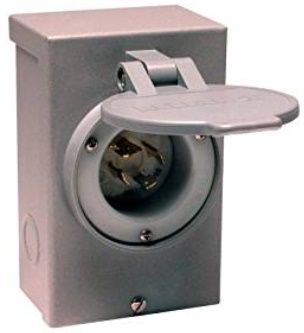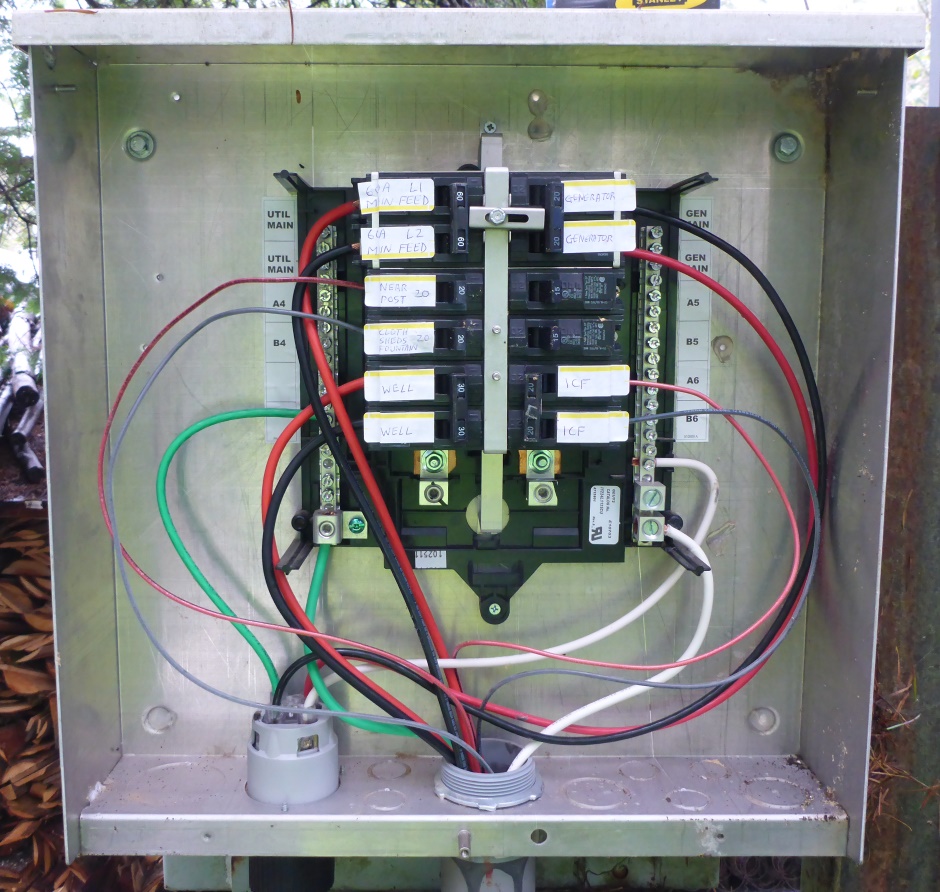Home Site Map - Techniques - Electrical -
Electrical Backup Power
![]() Designing your electrical system so it can switch to generator power
in a blackout.
Designing your electrical system so it can switch to generator power
in a blackout.
Backup Power
General principle
You cannot just feed power from a generator back into your house wiring. This would be very dangerous and may electrocute power workers who are working to restore utility power to your house. It is necessary to have proper certified changeover switches that switch from utility power to generator power via a completely off state. You could use a huge switch into your main panel for this, but a much better idea is to just provide power on the circuits that you will actually need during a power outage.
Example things that need power during an outage include:
Well water pressure pump
Well submersible pump
Fridge/freezer
Lights
PC and home network for internet
TV
Fans etc for heating system
One or two small electrical heaters
Septic systems don't need to be powered during a power outage, assuming the outage only lasts a maximum of a week because the first tank has enough extra capacity without being pumped into the second tank.
In practice you will want to keep the total power usage to under about 4000 watts so that you can buy a mainstream economical generator. Here are some guideline power usage figures...
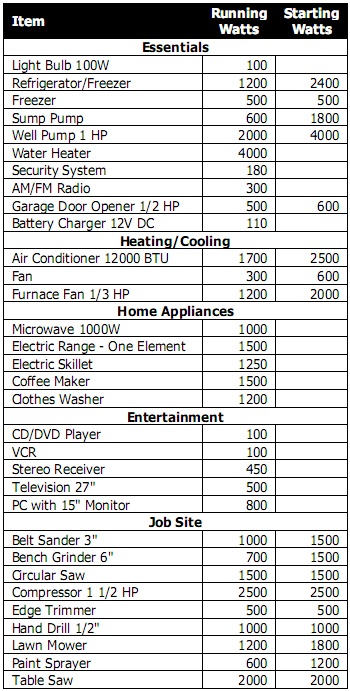
Generator
It is very important to get a generator that has a 230V (ie dual pole) output.
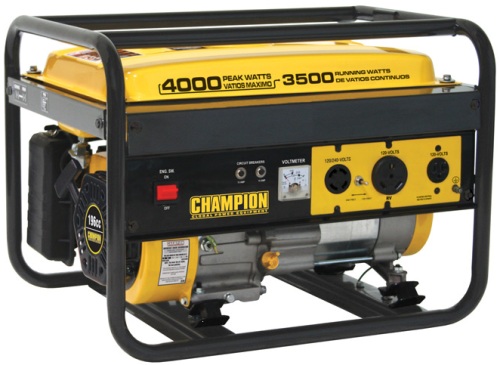 Details
are here .
Details
are here .
I recommend buying two economically priced generators rather than one more expensive one so that you have redundancy rather than a single point of failure. It is good to use a generator that can work with both gas (as per a car) and propane.
Generator Transfer Panel
Once you have decided which circuits will need power, you wire from the generator transfer panel. The generator transfer panel looks like and behaves like a subpanel. The unit chosen needs to be able to accommodate arc-fault breakers.
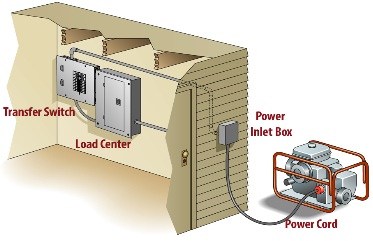
The best units are made by GenTran. They do internal and external versions with various power handling capabilities. Here's one I think is a good choice for outside use...
GenTran R200660 20-Amp 6-Circuit Outdoor Generator Transfer Switch for Generators up to 5000 Watts
Details are here (including installation instructions).
The instructions actually make it sound harder than it really is. You feed the transfer panel from a 60A dual breaker in the Main Panel. This goes via four 6-guage wires to the Transfer Panel. Because the Transfer Panel is a Sub-Panel, the earth and neutral is kept separate. All things that you want to be available for backup power you wire to the breakers in the transfer panel.
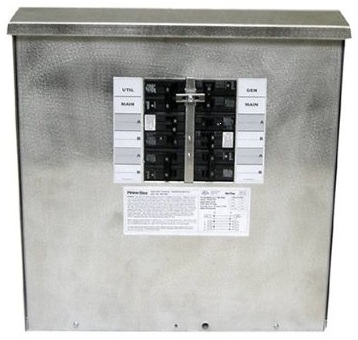
For use inside your house you can use an internal version, but I chose to use the outside version even inside the house as it happenedto be less expensive. Only the internal versions have power balancing meters, but that's not really needed.
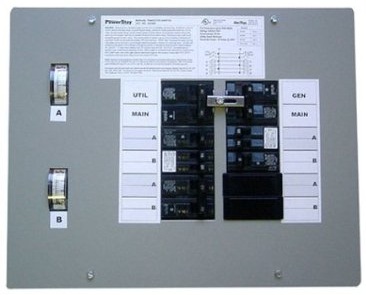
Here's the GenTrans wiring details (both internal and external) (click image for higher resolution)...
An interesting point is that all the circuits that you decide need power during an outage will always be powered by the generator transfer panel even when not using a generator. To cater for the fact that you will not be as power conscious when not in a power outage, the generator transfer panel can provide more power when not in generator mode. The GenTran units shown above are fed with a dual pole 60 amp breaker from the main panel. You need to make sure the maximum current you ever use when not in a power outage is below that dual pole 60 amps.
Exterior connection box and cable
If mounting inside then you will need a connection box on the outside of your house (the generator MUST be used outside because of exhaust fumes). Mount the socket in an electrical box on the outside wall.
When wiring an L14-20 (or an L14-30) plug or socket, G is (green) ground, W is (white) neutral, Red and Black are the interchangeable Live1 and Live2 and go on the X and Y terminals.
https://smile.amazon.com/gp/product/B01JNWZN66/ref=ox_sc_act_title_1?ie=UTF8&psc=1&smid=A21SDU20CEFN4K
$74.95 + tax for 40 feet
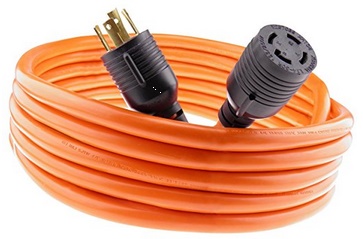
For the transfer panel you will need to put an L14-20 plug on the end of the wire (instead of an L14-30 plug). The wiring for an L14-30 plug is as per this diagram (from: http://www.smps.us/portablegenerators.html)...
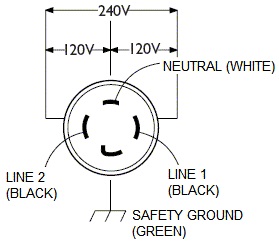
On the outside wall of you house you need...
Other details and my plot specific details
In my case because of the configuration of the wiring around my property, I need two transfer panels and two generators, ie two separate setups. My main panel and my electricity meter are mounted outside on the driveway. There are feeds from there to the well house and various out buildings, as well as a feed to the subpanel in the main house. I use an external generator transfer panel and generator to power the well house and out buildings during a power outage.
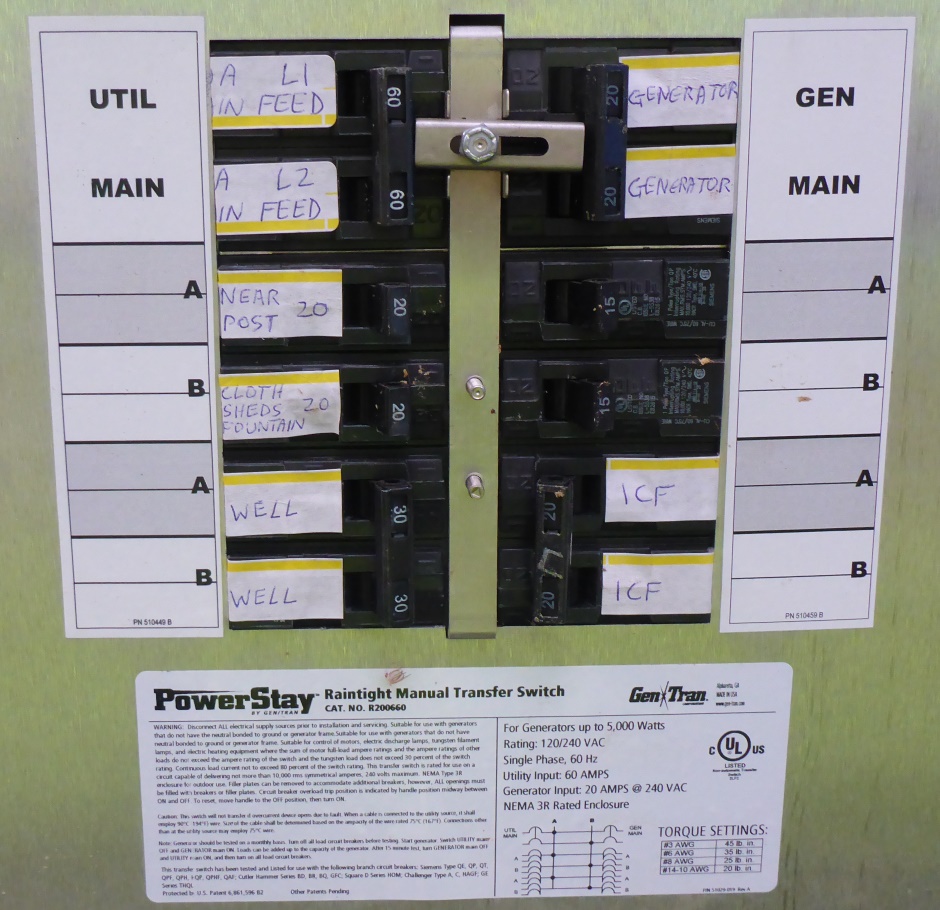
Inside the house, next to the internal subpanel that does lighting and electronics, I use another generator transfer panel fed via an external connector box and another generator. Note that the other house subpanel that powers the heavy current appliances does not have any power backup so none of these will be able to operate during a power outage.
The two generators are both 4000W and are interchangeable and movable. If one fails then one generator will be used most of the time for the house, but moved to the outside transfer panel for 10 minutes whenever the water pressure has dropped (and the faucets stop working). Note that even when both generators are functional, it is only necessary to run the generator on the external panel that feeds the well house occasionally and this will save gas.
Take heed of the fact that you can never exceed dual pole 60 amps even when not in a power outage. Here are the calculations for the external generator transfer panel...
Well submersible pump 6A 230V (Dual pole)
Water pressure pump 10A
230V (Dual pole)
Power tools in the well house 14A 110V (Single
pole)
Well house heater 14A 110V
(Single pole)
The Well house needs a 30A dual pole breaker. That leaves only 30A for everything else fed from the external generator transfer panel.
During a power outage it is necessary to keep the well house power usage to under 20A dual pole or the generator circuit breaker (in the transfer panel or on the actual generator) will keep tripping. If this happens then you will need to in the well house sub-panel turn off the breaker to the submersible pump and just rely on the stored water in the tank. If the tank runs dry then turn off the breaker to the pressure pump and let the submersible pump have power for a while.
The septic system does not need to be fed from a generator transfer panel on the assumption that a power outage will be less than a day or two. To allow for a more serious longer outage you would need to temporarily run wiring to one of the breakers on the transfer panel and temporarily turn off the breaker to the well house (or other 20A load). You would do this every couple of days to pump sewage from the first tank to the second tank and out to the drain field.
It is not practical to have your garage (with lots of power tools etc) all powered from the generator transfer panel. Instead you should pick a suitable 20A single pole (ie 115V) power outlet in the yard that is powered by the generator transfer panel and then run an extension cord if you need a particular power tool during a power outage. Alternatively have a couple of special dedicated and marked sockets in the garage. If it is an out-building without power tools then it is practical to feed it from the Transfer Panel.
My particular breaker configurations
Site main panel
Mobile Home / Garage 200A L1+L2
Main House Primary 200A L1+L2
Main House Secondary 200A L1+L2
| Name |
Breaker |
L1/L2 |
L1/L2 |
Breaker |
Name |
|
|---|---|---|---|---|---|---|
| Unknown (was other side) |
20 | L1 | |
L1 | 30 | Robbie Shed L1 |
| Unknown (was other side) | 20 | L2 | |
L2 | 30 | Robbie Shed L2 |
| Unknown |
20 | L1 | |
L1 | 30 | TinyHouse L1 |
| Yard South Lamp Posts |
20 | L2 | |
L2 | 30 | TinyHouse L2 |
| Tesla Charger L1 |
30 | L1 | |
L1 | 60 | TransferPanel L1 |
| Tesla Charger L2 | 30 | L2 | |
L2 | 60 | TransferPanel L2 |
| SawMill L1 |
40 | L1 | |
L1 | 100 | Temp MainHouse L1 |
| SawMill L2 |
40 | L2 | |
L2 | 100 | Temp MainHouse L2 |
Yard transfer panel
| Name |
Breaker |
L1/L2 |
L1/L2 |
Breaker |
Name |
|
|---|---|---|---|---|---|---|
| Near post power outlet |
20 | L1 | |
L1 | 15 | (Unused) |
| Cloth Sheds & Fountain | 20 | L2 | |
L2 | 15 | (Unused) |
| Wellhouse L1 |
30 | L1 | |
L1 | 20 | ICF Shed L1 |
| Wellhouse L2 |
30 | L2 | |
L2 | 20 | ICF Shed L2 |
High current house sub-panel
| Name |
Breaker |
L1/L2 |
L1/L2 |
Breaker |
Name |
|
|---|---|---|---|---|---|---|
| 1 | L1 | L1 | ||||
| 2 | L2 | L2 | ||||
| 3 | L1 | L1 | ||||
| 4 | L2 | L2 | ||||
| 5 | L1 | L1 | ||||
| 6 | L2 | L2 | ||||
| 7 | L1 | L1 | ||||
| 8 | L2 | L2 | ||||
| 9 | L1 | L1 | ||||
| 10 | L2 | L2 | ||||
| 11 | L1 | L1 | ||||
| 12 | L2 | L2 | ||||
| 13 | L1 | L1 | ||||
| 14 | L2 | L2 | ||||
| 15 | L1 | L1 | ||||
| 16 | L2 | L2 | ||||
| 17 | L1 | L1 | ||||
| 18 | L2 | L2 | ||||
| 19 | L1 | L1 | ||||
| 20 | L2 | L2 |
Low current house sub-panel
| Name |
Breaker |
L1/L2 |
L1/L2 |
Breaker |
Name |
|
|---|---|---|---|---|---|---|
| 1 | L1 | L1 | ||||
| 2 | L2 | L2 | ||||
| 3 | L1 | L1 | ||||
| 4 | L2 | L2 | ||||
| 5 | L1 | L1 | ||||
| 6 | L2 | L2 | ||||
| 7 | L1 | L1 | ||||
| 8 | L2 | L2 | ||||
| 9 | L1 | L1 | ||||
| 10 | L2 | L2 | ||||
| 11 | L1 | L1 | ||||
| 12 | L2 | L2 | ||||
| 13 | L1 | L1 | ||||
| 14 | L2 | L2 | ||||
| 15 | L1 | L1 | ||||
| 16 | L2 | L2 | ||||
| 17 | L1 | L1 | ||||
| 18 | L2 | L2 | ||||
| 19 | L1 | L1 | ||||
| 20 | L2 | L2 |
House transfer panel
| Name |
Breaker |
L1/L2 |
L1/L2 |
Breaker |
Name |
|
|---|---|---|---|---|---|---|
| Kitchen Socs Microwave |
20 | L1 | |
L1 | 30 | Family Water Heater |
| Main Socs | 20 | L2 | |
L2 | 30 | Family Water Heater |
| Kitchen Fridge Extra Soc |
20 | L1 | |
L1 | 15 | Server Basement |
| East Room Socs |
20 AFCI | L2 | |
L2 | 15 | Lights Base socs |
Notes
(Gen) Kitchen Socs Microwave
One bench (8 socs) fed from
one GFCI
Use plugin cooktop rather than main
cooktop
Kettle (13A)
Coffee
maker (10A)
(Gen) Main Socs
Living room power
sockets (plug in mobile radiator) (3 soc), TV etc (3 socs)
Utility room (one twin soc)
Socket in bathroom
(Gen) Kitchen Fridge
Use twin power
outlet
(Gen) Bedroom Socs
One twin socket in each bedroom
and landing (total of 10 twin socs)
Sockets in
bathrooms
(Gen) Family Water Heater L1
One side of 2500W 240V 11A element for family hot water heater.
Need to fit water heater with 2500W 240V elements.
(Gen)
Family Water Heater L2 Basement
Freezer
Other side of 2500W 240V 11A element for family
hot water heater.
Need to fit water heater with
2500W 240V elements.
(Gen)
Server Basement
Internet switches, server PC &
discs
(Gen) Main Bed Base Lights, Base Socs
LED lights so
not much power
Just 4 special basement socs
Things that will not work in a power outage
Washing machine
Clothes dryer
Ovens
Induction cook top
Big hot water heaters
Hot water heat pump
In-wall oil radiators
Hot water heater
Need to fit water heater with 2500W 240V elements rather than the usual 4500W 240V elements.
This will mean that the heat time (or rather recovery time) for
the family hot water is a bit slow even when there is not a power
outage. This may be ok (suck it and see), particularly as there
are 50 gallons of full temperature hot water available before recovery
is needed. If this is a problem then will need to buy an extra
water heater that is dedicated to power outages.




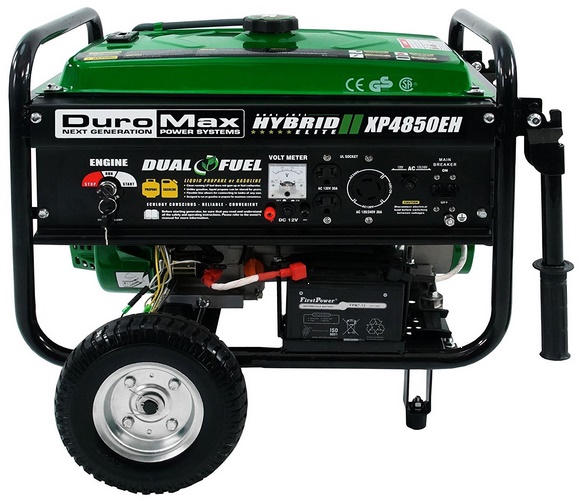
.jpg)
